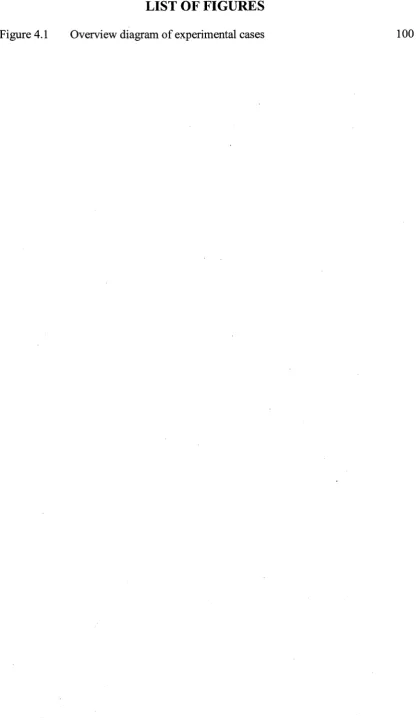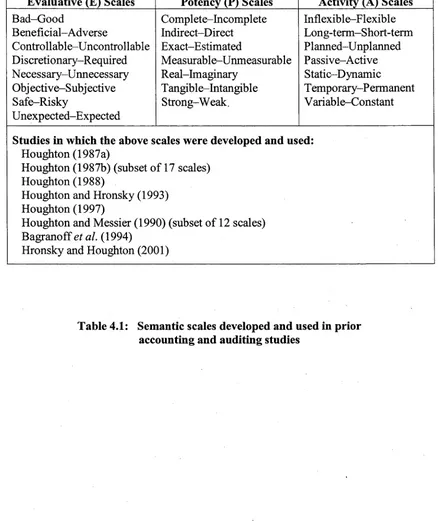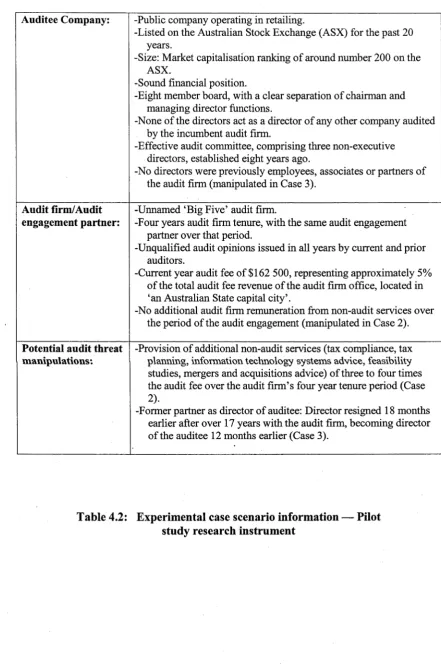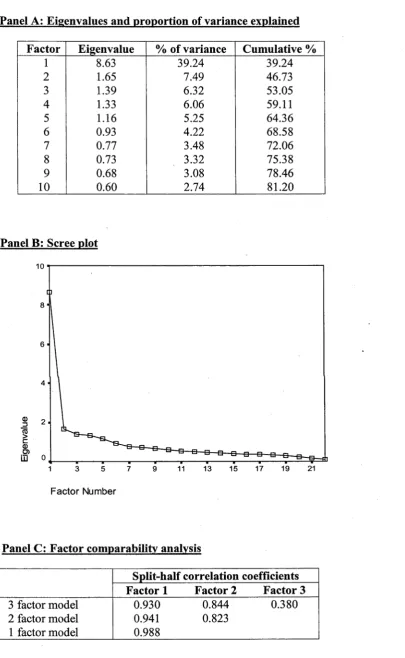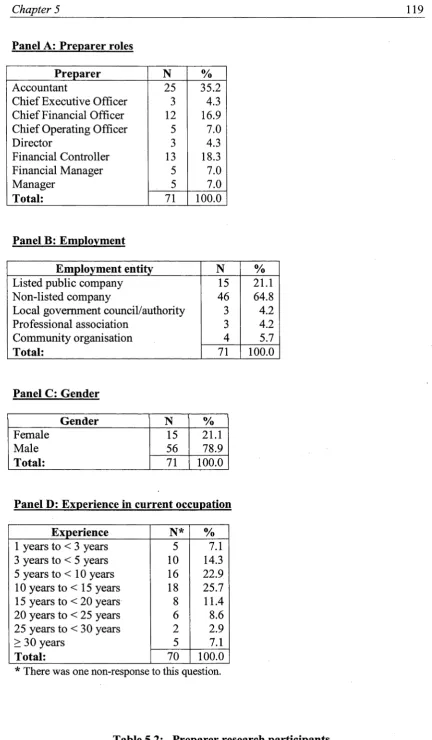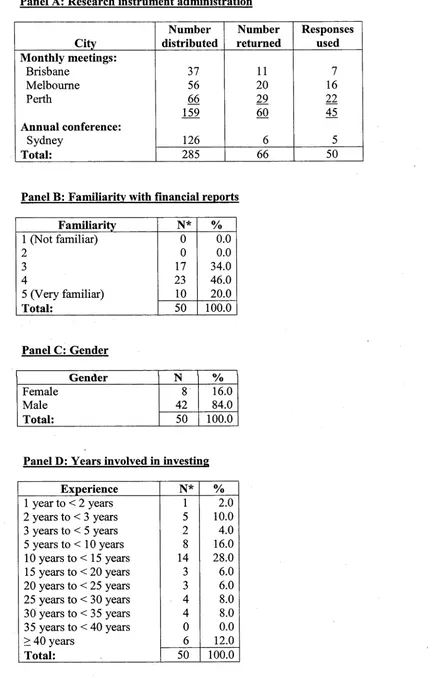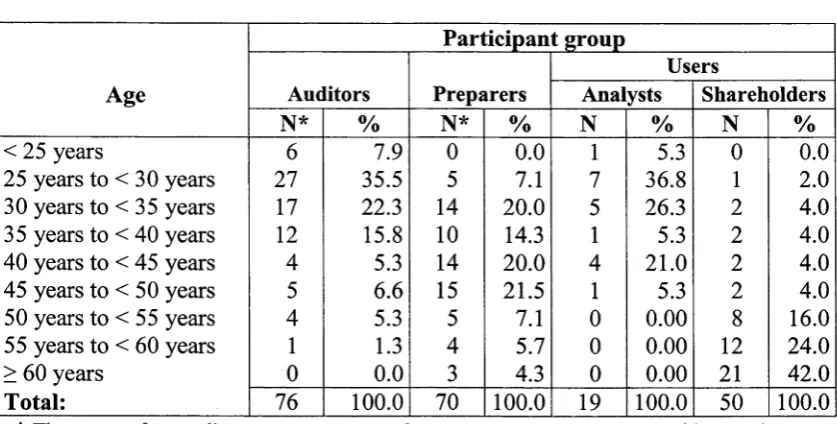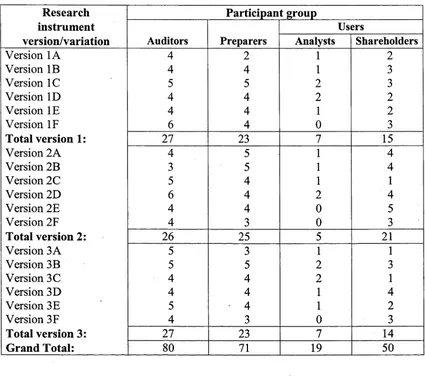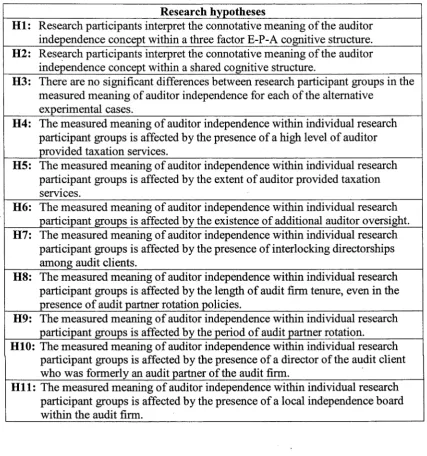AUDIT: DEMAND AND SUPPLY SIDE INTERPRETATIONS
by
GRAEME LESLIE WINES
BBus (Deakin), DipEd (SCV Hawthorn), GradDipAcc (Deakin), MEc (New England), FCPA (CPA Australia)
A thesis submitted for the degree of Doctor of Philosophy of
The Australian National University
I hereby declare that this thesis is the entire work o f the author and has not been submitted to any other university or educational institution for the award o f any other degree. Furthermore, all sources used in the production o f this thesis have been acknowledged in the usual manner.
Signed: ...
Graeme L. Wines
... S .9 . j. h T r r tX ^ .
P71. ..
I owe a debt of gratitude to my supervisor, Professor Keith Houghton, for his
considerable support, encouragement and guidance throughout this research. I
particularly thank him for the considerable time he willingly gave to help me see the
project through to its completion.
I also wish to thank Professor Des Nicholls for statistical advice, and Helen
Scarborough and Peter Dryden for their review of thesis drafts and their many useful
comments. I am also indebted to the many research participants who made this
research possible.
I also thank seminar participants at the Australian National Centre for Audit and
Assurance Research (ANCAAR, The Australian National University) and Deakin
University for their valuable feedback. The research has also benefited from
comments of attendees at the 2007 annual conferences of the Accounting and Finance
Association of Australia and New Zealand (AFAANZ) and the American Accounting
Association (AAA).
Finally, but not least, I sincerely thank Megan, Josh, Jacob, Ellen and Ben for their
support, especially as it is invariably all family members who are affected by the
Accounting represents a process of communication, with this communication
primarily achieved via the financial reporting function. Users of financial reports,
though, may harbour doubts and uncertainties with respect to the accounting
processes by which financial reports are constructed and with respect to the resulting
quality of the communicated information. Auditors therefore fulfil an assurance role.
A key reason they can fulfil this role is their independence from the managements of
the entities they audit.
This experimental study investigates the meaning of the concept of auditor
independence utilising the measurement o f meaning (semantic differential)
framework originally proposed by Osgood, Suci and Tannenbaum (1957). The
research provides insight into whether there is shared meaning of the concept of
auditor independence between key parties to the financial reporting communication
process and the extent to which those meanings are affected by various potential
threats to, and safeguards of, auditor independence. The threats and safeguards
examined represent contemporary auditor independence issues.
The experimental cases developed for the study allow examination of the impact on
interpretations of auditor independence of alternative potential independence threats
and safeguards. The potential auditor independence threats manipulated in the study
were (a) non-audit services, (b) interlocking directorships among audit clients,
(c) longer periods of audit firm tenure, and (d) a former audit firm partner being a
director of the auditee company. The auditor independence safeguards manipulated
firm.
At a general level across all experimental cases, the three groups of research
participants (auditors, financial report preparers and financial report users) were
found to have a shared meaning of auditor independence. The major individual area
in which there was a significant between-group difference in connotations
(interpretations) of independence was that of the auditor provision of non-audit
services.
Analysis of the experimental cases indicated that (a) significant differences in
connotations of an auditor’s independence existed between the auditor participants
and the other two participant groups in the presence of audit firm provided non-audit
services, even though the services were specified to comprise only traditional taxation
services, (b) preparers and users exhibited equal independence concerns for low and
high levels of taxation services, (c) in the presence of a high level of taxation
services, none of the three participant groups perceived benefits to auditor
independence from additional audit firm oversight by a public oversight board, (d) all
groups perceived an adverse impact on auditor independence when interlocking
directorships were present, (e) a longer period of audit firm tenure was not interpreted
to adversely affect auditor independence when audit partner rotation policies exist,
and this was unaffected by whether audit partner rotation occurred every four years or
every seven years, (f) all participant groups agreed on the adverse impact on
independence of a former audit firm partner being a director of the auditee company,
even though it was specified that the former partner had not previously been involved
in the audit of the auditee, and (g) the auditor and user participants agreed on the
TABLE OF CONTENTS
DECLARATION ii
ACKNOWLEDGMENTS iii
ABSTRACT iv
TABLE OF CONTENTS vi
LIST OF APPENDICES xi
LIST OF FIGURES xii
LIST OF TABLES xiii
CHAPTER 1 INTRODUCTION 1
1.1 The issue addressed in the thesis 2
1.2 Objectives of and motivations for the research 5
1.3 Contributions to knowledge 7
1.3.1 Theoretical implications 8
1.3.2 Policy implications 8
1.4 Organisation of the thesis 9
CHAPTER 2 THE AUDIT FUNCTION, AUDITOR INDEPENDENCE AND THE MEANING OF THE INDEPENDENCE
CONCEPT 12
2.1 The audit and assurance functions 12
2.1.1 Nature of the audit function 12
2.1.2 Assurance services 16
2.2 The regulatory and institutional framework for statutory company audits
in Australia 18
2.3 The concept of auditor independence 25
2.4 Auditor independence threats and safeguards 31
2.5 Recent auditor independence developments 33
2.5.1 Australian developments 34
2.5.2 Developments in the United States 42
2.6 Interpretations of the meaning of the independence concept 45
CHAPTER 3 THE MEASUREMENT OF MEANING:
A FRAMEWORK FOR RESEARCH 51
3.1 General research question 51
3.2 The measurement of meaning framework and semantic differential
analysis 52
3.2.1 Overview of the measurement of meaning framework 52
3.2.2 Factor analysis and the measurement of meaning 57
3.3 Prior accounting and auditing measurement of meaning studies 64
3.3.1 Foundation accounting and auditing studies 64
3.3.2 Further accounting and auditing studies 69
3.4 Investigative questions 73
3.5 Summary 74
CHAPTER 4 RESEARCH INSTRUMENT CONSTRUCTION 75
4.1 Pilot Study 76
4.1.1 Pilot study research instrument 85
4.1.2 Pilot study research participants 85
4.1.3 Pilot study results 86
4.1.4 Conclusions from the pilot study 96
4.2 Final research instrument 98
4.2.1 Semantic differential scales 98
4.2.2 Experimental case scenarios 98
4.2.3 Research instrument: Alternative versions and variations 103
4.2.4 Format of research instrument 108
4.3 Summary 109
CHAPTER 5 RESEARCH PARTICIPANTS 111
5.1 Sample size considerations 112
5.2 Auditors 113
5.3 Financial report preparers 117
5.4 Financial report users 120
5.4.1 Bank analyst research participants 120
5.4.2 Private shareholder research participants 123
5.5 Research participant comparative descriptive statistics 127
CHAPTER 6 DEVELOPMENT OF RESEARCH HYPOTHESES 133
6.1 Experimental cases 133
6.1.1 Independence threats 134
6.1.1.1 Auditor provision of non-audit services 134
6.1.1.2 Interlocking directorships among audit clients 152
6.1.1.3 Period of audit firm tenure 157
6.1.1.4 Former audit firm partner as a director of the auditee 164
6.1.2 Independence safeguards 168
6.1.2.1 Audit subject to additional external oversight 168
6.1.2.2 Auditor rotation 176
6.1.2.3 Local independence board within the audit firm 183
6.1.3 Summary: Potential independence threats and safeguards 189
6.2 Hypotheses: Cognitive Structure 190
6.3 Hypotheses: Experimental cases and measured meaning 191
6.3.1 Between-group differences 192
6.3.2 Within-group differences 192
6.3.2.1 Non-audit services and additional external oversight 193
6.3.2.2 Interlocking directorships among audit clients 197
6.3.2.3 Longer period of audit firm tenure and audit partner
rotation 198
6.3.2.4 Former audit firm partner as a director of the auditee and
local independence board 200
6.4 Summary 203
CHAPTER 7 INITIAL DATA ANALYSIS 206
7.1 Sample size across participant groups and experimental cases 206
7.2 Manipulation checks 208
7.3 Semantic differential scale descriptive statistics 214
7.4 Correlation matrices 216
7.4.1 Evaluative scales 216
7.4.2 Potency scales 219
7.4.3 Activity scales 222
7.5 MANOVA of semantic differential scale data 224
7.6 Perceptions of auditor independence 229
CHAPTER 8 RESEARCH FINDINGS: COGNITIVE STRUCTURE 236 8.1 Factor analysis: Component analysis versus common factor analysis 237
8.2 Initial factor analysis results 240
8.3 Four factor model 243
8.4 Three factor model 248
8.5 Two factor model 252
8.6 Single factor model 255
8.7 Discussion of cognitive structure 257
8.8 Summary 261
CHAPTER 9 RESEARCH FINDINGS: BETWEEN-GROUP
COMPARISONS OF EXPERIMENTAL CASES 263
9.1 Between group comparisons of semantic scale data by case 264
9.2 Factor placements at the aggregated case level 268
9.3 Between-group comparisons at the aggregated case level 271
9.4 Factor placements at the individual case level 275
9.5 Between-group comparisons at the individual case level 278
9.6 Summary 283
CHAPTER 10 RESEARCH FINDINGS: WITHIN-GROUP
COMPARISONS OF EXPERIMENTAL CASES 284
10.1 Non-audit services and public oversight board 284
10.2 Interlocking directorships among audit clients 292
10.3 Longer period of audit firm tenure and audit partner rotation 296 10.4 Former partner as director of auditee and local independence board 299
10.5 Summary 304
CHAPTER 11 SUMMARY AND CONCLUSIONS 306
11.1 Summary of the research 306
11.2 Summary of the research conclusions 308
11.2.1 Cognitive structure and shared meaning 310
11.2.2 Between-group comparisons of experimental cases and shared
meaning 310
11.2.3 Within-group comparisons of experimental cases 311
11.3 Limitations of the research 313
11.3.1 Statistical conclusion validity 313
11.3.2 Internal validity 316
11.3.3 Construct validity 317
11.4 Implications of the research 324
11.4.1 Theoretical implications 325
11.4.2 Methodological implications 326
11.4.3 Policy implications 327
11.4.4 Future research implications 335
11.5 Chapter summary 339
APPENDICES 340
LIST OF APPENDICES
Appendix 1 Pilot study research instrument 340
Appendix 2 Final research instrument: 349
2.1 Cover sheet and instructions 350
2.2 Experimental cases 354
2.3 Response sheets 364
2.4 Manipulation checks 368
2.5 Biographical details 372
Appendix 3 Factor comparability analysis: Alternative four factor
models: 375
3.1 Maximum likelihood factoring with varimax rotation 376 3.2 Principal axis factoring with direct oblimin rotation 377 3.3 Maximum likelihood factoring with direct oblimin rotation 378
Appendix 4 Factor comparability analysis: Alternative three factor
models: 379
4.1 Maximum likelihood factoring with varimax rotation 380 4.2 Principal axis factoring with direct oblimin rotation 381 4.3 Maximum likelihood factoring with direct oblimin rotation 382
Appendix 5 Factor comparability analysis: Alternative two factor
models: 383
LIST OF FIGURES
LIST OF TABLES
Table 4.1 Semantic scales developed and used in prior accounting and
auditing studies 79
Table 4.2 Experimental case scenario information — Pilot study research
instrument 81
Table 4.3 Pilot study descriptive statistics 87
Table 4.4 Pilot study eigenvalues, scree plot and factor comparability
analysis 89
Table 4.5 Pilot study two factor cognitive structure 91
Table 4.6 Pilot study case placements within two factor cognitive structure 94 Table 4.7 Experimental case scenario information — Final research
instrument 101
Table 4.8 Alternate versions of the research instrument 106
Table 5.1 Auditor research participants 116
Table 5.2 Preparer research participants 119
Table 5.3 Bank analyst research participants 122
Table 5.4 Shareholder research participants 126
Table 5.5 Research participant comparative descriptive statistics 129
Table 5.6 Research instrument versions administered 131
Table 6.1 Research hypotheses 204
Table 7.1 Summary of research sample size by experimental case
and participant group 207
Table 7.2 Summary of manipulation checks 209
Table 7.3 Analysis of manipulation checks 213
Table 7.4 Semantic differential scale descriptive statistics 215
Table 7.5 Correlation matrix — Evaluative scales 218
Table 7.6 Correlation matrix — Potency scales 221
Table 7.7 Correlation matrix — Activity scales 223
Table 7.8 MANOVA results for semantic differential scale data 226
Table 7.9 MANOVA results by research participant group 228
Table 7.10 Univariate ANOVA of seven point scale perception responses 231 Table 7.11 Univariate ANOVA of seven point scale perception responses
by group 232
Table 7.12 Logistic regression of dichotomous scale perception responses 234
Table 8.1 Eigenvalues and scree plot 242
Table 8.2 Rotated factor matrix — Four factor model 244
Table 8.3 Factor comparability analysis — Four factor model 246
Table 8.5 Factor comparability analysis — Three factor model 251
Table 8.6 Two factor model 254
Table 8.7 Single factor model 256
Table 9.1 MANOVA of semantic scales — Between-group differences in
individual cases 265
Table 9.2 Factor placements — Aggregated cases 269
Table 9.3 One-way ANOVA of factor placements — Aggregated cases 272
Table 9.4 Factor placements — Individual cases 276
Table 9.5 One-way ANOVA of factor placements — Individual cases 279
Table 10.1 Case placements — High non-audit (taxation) services 287
Table 10.2 Case placements — Low and high non-audit (taxation) services 290
Table 10.3 Case placements — Interlocking directorships 295
Table 10.4 Case placements — Longer period of audit tenure and audit
partner rotation 298
Tablel 0.5 Case placements — Former partner as director of audit client
and internal independence board 302
CHAPTER 1
INTRODUCTION
Accounting represents a process of communication. In the context of communication
by reporting entities in capital markets, this communication is primarily achieved via
the financial reporting function (see, for example, Bedford and Baladouni, 1962;
Goldberg, 1965; McClure, 1983; Australian Accounting Research Foundation, 1990;
Houghton, 1997). However, users of financial reports may harbour doubts and
uncertainties with respect to the accounting processes by which financial reports are
constructed and with respect to the resulting quality of the communicated information
(Lee, 1993). The demand for auditing is therefore derived from a demand to monitor
and arbitrate on the application of accounting methods, to control the behaviour of
managers in this respect and to verify the financial report (see, for example, Jensen
and Meckling, 1976; Antle, 1982; Ball, 1989; Anderson, Francis and Stokes, 1993).
The aim of the audit function is to establish that communicated financial reports have
a high degree of credibility and to create rational belief and confidence in those
reports (Lee, 1993). An audit aims to provide assurance to the various stakeholders
that the financial report information meets specified quality standards (Wolnizer,
1987; Lee, 1993). A major reason auditors can fulfil this assurance role is their
independence from the managements who are responsible for the contents of financial
reports (see, for example, De Angelo, 1981a; Watts and Zimmerman, 1981, 1983;
This experimental study investigates the meaning of the concept of auditor
independence using the measurement o f meaning (semantic differential) framework
originally proposed by Osgood, Suci and Tannenbaum (1957). The aim of the
research is to provide insight into whether there is shared meaning of the concept of
auditor independence between key parties to the financial reporting (accounting)
communication process and the extent to which those meanings are affected by
various potential threats to, and safeguards of, auditor independence. The key parties
to the financial reporting communication process are central capital market
participants with respect to the financial reporting function.
The research provides further theoretical and empirical insight into the concept of
independence. It will also provide guidance for regulators, professional accounting
bodies, educators and, especially, auditing standard setters. Although a large volume
of auditor independence research exists, the issues examined in the study have not
previously been investigated from the perspective of the measured meaning of the
auditor independence concept. The Osgood et al. (1957) measurement of meaning
framework allows investigation of the connotative meaning of the independence
concept, this comprising the emotional associations, evaluations and judgments of the
concept (Osgood et al., 1957; Flamholtz and Cook, 1978; Bruno, 1980; Bagranoff,
1990).
1.1 THE ISSUE ADDRESSED IN THE THESIS
The audit function aims to provide assurance that communicated financial reports
meet specified quality standards in order to satisfy the information needs of capital
market participants. Audit quality is dependent on a whole range of factors related to
quality emphasise an auditor’s competence and independence (DeAngelo, 1981a;
Watts and Zimmerman, 1981). Auditor independence is fundamental to the audit
function and a major factor impacting on audit quality. Independence has historically
been seen to be one of the foremost standards with which auditors should comply,1
and this continues to be the case. In fact, it is fair to say that auditor independence has
become of increased importance over the past five or six years following the spate of
corporate collapses earlier this decade involving, for example, Enron and WorldCom
in the United States and HIH Insurance and One.Tel in Australia.
The primary objective of an audit is for the auditor to ‘provide independent assurance
to the shareholders that the directors have prepared the financial statements properly’
(Auditing Practices Board, 2004a, para. 3, emphasis added). Independence is a major
factor influencing an auditor’s reputation (see, for example, Benston, 1975; Firth,
1990; Wilson and Grimlund, 1990), and Johnstone, Sutton and Warfield (2001, p. 2)
state that independence ‘is the most fundamental and vital asset possessed by the
auditing profession.’
Professional accounting bodies and regulators have generally operationalised the
independence concept by requiring auditors to be independent in fact and in
appearance (see, for example, International Organization of Securities Commissions,
2002b; International Federation of Accountants, 2005; Accounting Professional and
Ethical Standards Board, 2006a; American Institute of Certified Public Accountants,
2006). The independence pronouncements and standards issued by the various
professional accounting organisations and regulatory bodies represent their attempts
to provide a definition of auditor independence and to provide guidance for auditors
when considering their independence in practice. The various statements therefore
elaborate on the meaning of the concept of auditor independence, particularly by
providing definitions and explanations of independence and by providing rules
regarding various threats to auditor independence and safeguards that can be
implemented to mitigate threats to reduce them to an acceptable level.
For the concept of auditor independence to be effectively implemented in practice, it
is necessary for a shared understanding of the meaning of the concept to exist.
However, it may be difficult for auditors to effectively consider and evaluate their
independence, particularly in marginal situations, if the meaning of independence in
the context of an audit is subject to ambiguity and uncertainty and if their
interpretation of the meaning of the concept differs from that of other key parties and
stakeholders. Many current professional pronouncements and other documents
specify a general test for auditor independence based on what a reasonable and
informed investor or other third party, having knowledge of all relevant facts and
circumstances, would conclude to be acceptable (see, for example, Auditing Practices
Board, 2004a; International Federation of Accountants, 2005; Accounting
Professional and Ethical Standards Board, 2006b; American Institute of Certified
Public Accountants, 2006). These statements require the auditor to identify and
evaluate circumstances and relationships that create threats to independence and to
take action by applying appropriate safeguards. However, what auditors and other
reasonable and informed parties would conclude to be acceptable is largely dependent
on their interpretation of the meaning of the concept of auditor independence,
particularly in response to the various circumstances and conditions (threats and
The issue addressed in the study therefore focuses on whether there is shared meaning
of the concept of auditor independence between different key parties to the financial
reporting communication process.
1.2 OBJECTIVES OF AND MOTIVATIONS FOR THE RESEARCH
The research is designed to provide further investigation into the concept of auditor
independence using an innovative research method not previously applied in the
extant literature. The objective of the study is to determine the presence and extent of
shared meaning of this important concept between different parties to the financial
reporting communication process. The parties to the financial reporting
communication process used as research participants are auditors, financial report
preparers and financial report users.
Vigorous debate on auditor independence arose following the series of corporate
collapses earlier this decade involving companies such as Enron and WorldCom in
the United States and HIH Insurance and One.Tel in Australia. A number of formal
inquiries and reviews were commissioned and reports prepared in Australia and
internationally. These resulted in considerable substantive amendment to the
legislative and professional rules and guidelines with the aim of strengthening the
independence of auditors. As noted in the previous section, the pronouncements and
standards issued by the relevant professional and regulatory bodies, in defining
auditor independence and providing guidance for auditors, elaborate on the meaning
of the concept of auditor independence. The research is therefore motivated by the
various recent developments relating to the concept of auditor independence that may
independence is interpreted by different parties to the financial reporting
communication process.
It was noted in Section 1.1 that it is necessary for a common understanding of the
meaning of the concept of auditor independence to exist if it is to be effectively
implemented in practice. The study’s general research question is therefore stated as:
Is there shared meaning o f the auditor independence concept between key
parties to the financial reporting communication process?
The research framework for the measurement of meaning originally developed by
Osgood et al. (1957), and used in a number of prior studies examining accounting and
auditing concepts, is used to investigate the study’s general research question. In
investigating the general research question, the measurement of meaning framework
is used to investigate a number of contemporary auditor independence issues that
have been questioned in relation to the companies involved in the recent corporate
collapses and in the prior literature. These issues relate to (a) auditor independence
threats highlighted in the literature, (b) independence safeguards introduced to
mitigate independence threats, and (c) proposals for additional independence
safeguards.
The specific potential independence threats examined in the study encompass (a) the
auditor provision of non-audit services, (b) interlocking directorships among audit
clients, (c) longer periods of audit firm tenure, and (d) a former partner of the audit
firm being a director of the audit client. The independence safeguards involve
(a) additional auditor oversight by (i) an external body and (ii) a local (internal)
2
Interlocking directorships arise when company boards of directors include directors who also serve on the boards of other companies, creating networks of inter-company ties (Mizruchi,
independence board, and (b) audit partner rotation. The study is therefore motivated
by the ability of the Osgood et al. (1957) measurement of meaning framework to
provide valuable research into these contemporary issues, particularly from the
perspective of the way in which the threat and safeguard circumstances and
conditions affect interpretations of auditor independence.
Research into interpretations of the meaning of the auditor independence concept can
also be motivated by reference to the audit expectation(s) gap literature. The audit
expectations gap has been defined as a ‘divergence in expectations between auditors
and the users of the audit function in respect of the objectives of the independent
audit’ (Godsell, 1993, p. 1) and as ‘a representation of the feeling that auditors are
performing in a manner at variance with the beliefs and desires of those for whose
benefit the audit is being carried out’ (Humphrey 1997, p. 9). Auditor independence
has been argued to represent a central issue contributing to the expectations gap (see,
for example, Hooks, 1991; Godsell, 1993; Humphrey, Moizer and Turley, 1993;
Humphrey, 1997; Joint Committee of Public Accounts and Audit, 2002b). With
respect to auditor independence, the expectations gap suggests differences between
auditors and financial report users in interpretations of the meaning of the
independence concept in individual contexts.
1.3 CONTRIBUTIONS TO KNOWLEDGE
The findings of the research have theoretical and policy implications that will
contribute to knowledge. These applications are outlined in the following sub
1.3.1 Theoretical implications
The findings from the research will have theoretical implications. The study makes a
methodological contribution by utilising the measurement of meaning research
framework to examine a concept to which it has not previously been applied. The
framework has been used extensively in many disciplines and its reliability, validity
and effectiveness have been extensively tested (Heise, 1969; Kerlinger, 1973;
Fishbein and Azjen, 1975). However, only a relatively small number of prior studies
have applied the method to accounting and auditing concepts. The present study will
therefore add to theory by showing how the method can be applied to examine further
concepts within the auditing discipline.
In being the first study to apply the Osgood et al. (1957) measurement of meaning
research framework to examine the concept of auditor independence, a conclusion
can be drawn on whether the method represents a valid and useful tool for the
purpose of examining interpretations of independence in specific contexts and across
alternate parties to the financial reporting communication process. The study builds
on earlier research that has examined perceptions of auditor independence in different
contexts, in this case by focusing on contexts encompassing alternative potential
independence threats and safeguards. In particular, the study makes a theoretical
contribution by focusing on the three major groups of parties to the financial
reporting communication process (auditors, financial report preparers and financial
report users) in a single study.
1.3.2 Policy implications
The findings from the research also have policy implications for policy-makers. As
framework represents a valid and useful tool for the purpose of examining
interpretations of independence in specific contexts and across alternate parties to the
financial reporting communication process. This will be useful for policy-makers in
determining whether the method can provide a means to enable an improved
understanding of the effects of potential independence threat and safeguard
circumstances on interpretations of independence.
As noted in Section 1.2, the study investigates a number of contemporary auditor
independence issues that have been questioned in relation to the companies involved
in recent corporate collapses and in the prior literature. The research will therefore
have practical application for policy-makers by providing further information on
those specific independence issues.
In showing that the measurement of meaning framework can effectively be applied to
examine the concept of auditor independence, the study signifies that the method can
be utilised by policy-makers to prospectively evaluate the impact on interpretations of
independence of any proposed changes to auditor independence rules. This indicates
that, in developing new or revised rules, the method can be used by professional
bodies, regulatory bodies and researchers to assess the reaction of various interested
parties to any revisions prior to their finalisation. The method can also be used to
assess reactions to variations of any proposed measures.
1.4 ORGANISATION OF THE THESIS
Following the introduction to the research in this chapter, Chapter 2 provides a review
of relevant auditing and other literature concerning the nature of the audit assurance
Chapter 3 introduces the research framework for the measurement o f meaning
originally developed by Osgood et al. (1957). The chapter also provides an overview
of the prior accounting and auditing studies that have utilised the measurement of
meaning framework.
Chapters 4 and 5 describe the study’s research method. Procedures for the
construction of the study’s research instrument are explained in Chapter 4.
Development and administration of a pilot study used to guide development of the
study’s final research instrument is described, together with the pilot study results and
conclusions drawn. The final research instrument is also explained.
The study’s research participants, comprising auditors, financial report preparers and
financial report users, are described in Chapter 5. These participants represent the
major alternate groups of identifiable parties to the financial reporting communication
process. Procedures for administration of the research instrument with the participants
are also presented in the chapter.
The study’s research hypotheses are developed in Chapter 6. The prior literature, on
which the experimental case manipulations specified in the study’s research
instrument are based, is first presented. This literature provides the basis and
justification for the auditor independence threat and safeguard manipulations in the
experimental cases. This discussion is followed by development and statement of the
research hypotheses.
The results from a number of initial data analysis procedures are presented in Chapter
7. These procedures provide an initial understanding of the research data and ensure
The study’s data analysis results are presented and interpreted in accordance with the
study’s research hypotheses in Chapters 8 to 10. Chapter 8 presents findings related
to the cognitive structure within which the concept of auditor independence is
considered by research participants. Findings from an examination of the measured
meaning of auditor independence across the alternative experimental cases and
research participant groups are presented in Chapters 9 and 10. Findings from
between-group comparisons of the experimental cases are examined in Chapter 9,
while Chapter 10 examines differences within each of the participant groups between
related sets of experimental cases.
In concluding the thesis, Chapter 11 summarises the research findings and discusses
research limitations. It also discusses the theoretical, methodological and policy
CHAPTER 2
THE AUDIT FUNCTION, AUDITOR INDEPENDENCE
AND THE MEANING OF THE INDEPENDENCE
CONCEPT
This chapter provides an overview of the nature of the audit function and the concept
of auditor independence. The chapter commences with a description of the audit
function and the demand for auditing in Section 2.1, followed by an overview of the
Australian institutional framework for statutory corporate audits in Section 2.2. The
concept of auditor independence is introduced in Section 2.3. The conceptual
framework approach to independence, requiring auditors to identify and evaluate
independence threats and safeguards, is explained in Section 2.4. A summary of
major recent developments impacting on auditor independence, concentrating on
Australian developments, is presented in Section 2.5. Section 2.6 discusses issues
relating to interpretations of the meaning of the concept of auditor independence, and
a summary in Section 2.7 completes the chapter.
2.1 THE AUDIT AND ASSURANCE FUNCTIONS 2.1.1 Nature of the audit function
Accounting represents a process of communication (Bedford and Baladouni, 1962;
Goldberg, 1965; McClure, 1983; Houghton, 1997; amongst many others), with
communication primarily achieved through the financial reporting function
is associated with the accounting communication (financial reporting) process. Doubt
and uncertainty can arise with respect to the accounting content of financial reports
and the various accounting processes by which such reports are constructed (Lee,
1993). Of particular concern is the question of whether these processes provide the
designated recipients with financial information meeting specified quality standards
(Wolnizer, 1987; Lee, 1993). The audit function aims to provide this assurance.
An audit aims to establish the credibility of communicated financial reports and
create rational belief and confidence in those reports (Lee, 1993). The primary
objective of a financial statement audit is to ‘provide independent assurance to the
shareholders that the directors have prepared the financial statements properly’
(Auditing Practices Board, 2004a, para. 3, emphasis added). Management typically
has incentives to present the entity’s financial performance and financial position in
the best possible light, and may be motivated to present financial information that is
overly optimistic, misleading or false (Bazerman, Morgan and Loewenstein, 1997).
The auditor obtains and evaluates audit evidence to obtain reasonable assurance as to
whether the financial report gives a true and fair view or is presented fairly, in all
material respects, in accordance with the applicable financial reporting framework
(Auditing and Assurance Standards Board, 2006b; International Auditing and
Assurance Standards Board, 2006a).1 Sufficient and appropriate audit evidence must
be obtained to enable the auditor to draw reasonable conclusions on which to base the
audit opinion (International Auditing and Assurance Standards Board, 2004; Auditing
and Assurance Standards Board, 2006c).
In an audit pursuant to the Australian Corporations Act 2001 (Cth), sections 307 and 308 require the auditor to form and report an opinion on whether the company’s financial report is in accordance with the Act and accounting standards, and on whether the financial report conveys a
The audit of a financial report can be viewed as an agency function and cost in
situations where an agent, such as the board of directors of a company, is entrusted by
a principal, such as the company’s shareholders, to manage its resources and
operations and to report thereon (Wallace, 1980, 1987). Monitoring and bonding
mechanisms have the potential to control the behaviour of managers, and auditing is
one of these mechanisms (Jensen and Meckling, 1976).2 Auditing services are
demanded as monitoring devices due to the potential conflicts of interest between
owners and managers and between different classes of security holders (Watts, 1977;
DeAngelo, 1981a; Watts and Zimmerman, 1981, 1986).
The auditor acts as an arbiter to determine the consistency of the agent’s financial
statements with specified accounting procedures (Ball, 1989). By being independent
of those seeking capital, auditors add value in public capital markets by addressing
inherent conflicts of interest and by protecting the interests of capital providers
(Johnstone, Sutton and Warfield, 2001). By enhancing the credibility of financial
reports, the audit function enhances the effectiveness of capital markets in allocating
scarce resources by improving the decisions of financial report users, and also assists
in lowering the cost of capital to auditee entities by reducing information risk (see, for
example, Schuetze, 1994; Panel on Audit Effectiveness, 2000; Independence
Standards Board, 2001; Ramsay, 2001).
The demand for auditing can also be viewed from an information perspective, with
the audit function aiming to increase the quality of reported financial information
(Wallace, 1980, 1987). Public confidence in the operation of capital markets depends,
2 Other monitoring and bonding mechanisms include formal control systems, budget restrictions
in part, on the credibility of the opinions and reports issued by auditors (Auditing
Practices Board, 2004a). Investors demand audited financial reports as such reports
provide information that is useful to their investment decisions. An audit is also
valued as a means of improving the financial data utilised by managers for internal
decisions.3 The information perspective predicts a demand for audited financial
information ‘as a means of reducing the risk of investments, improving internal and
external decision making, enhancing gains from trade, and improving the portfolio
investment position of individuals’ (Wallace, 1980, p. 20).
A further demand for auditing is suggested by the insurance hypothesis. The audit
market literature suggests that a valued attribute of an audit is that of implicit
insurance.4 The insurance stems from the investor’s potential right to recover from
auditors any losses sustained by relying on audited financial statements that contain
misrepresentations (Dye, 1993; Menon and Williams, 1994; Stokes, 2002). If an
investor purchases shares or other securities on the basis of audited financial
statements and subsequently sustains losses, and if some form of audit failure can be
demonstrated, the legal system may provide recourse against the auditor. The auditor
thus ‘effectively functions as a potential (partial) indemnifier against investment
losses’ (Menon and Williams, 1994, p. 328). Unfortunately for auditors, it has been
For example, an audit can improve data for internal decision making by finding errors or by making employees more careful in preparing records subject to audit. Also, more accurate data for capital budgeting, inventory planning and production and pricing decisions can improve internal decision making (Wallace, 1980).
argued that they have become ‘the first tranche of insurance cover for investors and
creditors against losses incurred in a corporate failure’ (Bartholomeusz, 2002).5
In summary, the audit function aims to provide assurance to dispel or considerably
reduce doubts and uncertainties that may arise with respect to the accounting
processes by which accounting reports are constructed. The quality of the work of an
external auditor is said to significantly influence the public’s perception of the
credibility of financial reports (International Organization of Securities Commissions,
2002b). Indeed, it has been argued that a quality difference in audits converts to a
price differential in shares traded on stock markets (Houghton, 2002a; Houghton and
Jubb, 2003b, 2003c).
2.1.2 Assurance services
Recent developments have seen continuing change in the environment in which the
auditing profession operates. Largely due to the changing needs of users, the auditor’s
role is expanding beyond the traditional financial reporting function to a broader
range of assurance services and subject matters (Pound, 1997). It has been highlighted
that there is now ‘a much broader range of functions or activities for which
independent and expert opinions are being required’ (Gay and Simnett, 2000, p. 2).
Accordingly, in addition to the traditional financial report attestation audit, auditors
are increasingly providing broader assurance services. An assurance services
engagement has been defined as ‘an engagement where an independent professional
issues a written report that expresses a conclusion about the reliability of a subject
%
matter for which an accountable party is responsible’ (Schelluch and Gay, 1997, p. 1).
The American Institute of Certified Public Accountants (AICPA) released a report of
its Special Committee on Assurance Services, the Elliott Report, in 1997 (Special
Committee on Assurance Services, 1997). The report suggested that assurance
services represent the greatest opportunity for growth for the auditing profession and
that such services are expected to form a platform for the future evolution of the
profession. Assurance services are defined in the Elliott Report as ‘independent
professional services that improve the quality of information, or its context, for
decision makers’ (Special Committee on Assurance Services, 1997). The report states
that this definition encompasses audit and attestation engagements and also
accommodates many new service concepts.6
Information improvement is a core benefit of the audit-attest tradition, and this
provides a foundation for further value-added assurance services (Elliott and Pallais,
1997). The strengths and competencies of the audit profession, in terms of audit
methodology, standards, and techniques for evidence gathering and evaluation, have
value and applicability as a process beyond financial information and extend to
broader categories of information and assurance services (Pound, 1997). It has been
argued that members of the auditing profession have a competitive advantage over
other potential assurance providers because of their ‘professional standing, reputation
for independence and quality of services provided’ (Schelluch and Gay, 1997, p. 2,
emphasis added). The Elliott Report stressed that assurance services evolved naturally
from attestation and audit services, and that the ‘roots of all three are in independent
verification’ (Special Committee on Assurance Services, 1997, emphasis added).
Similarly, it has been argued that ‘it is the independence and expertise of the
practitioner that are sought after’ (Gay and Simnett, 2005, p. 9, emphasis added).
2.2 THE REGULATORY AND INSTITUTIONAL FRAMEWORK FOR STATUTORY COMPANY AUDITS IN AUSTRALIA
To provide a further background to the audit function, a brief overview of the
regulatory and institutional framework governing statutory company audits in
Australia is provided in this section. The major elements of the Australian regulatory
and institutional framework are (a) the Australian Corporations Act 2001, (b) the
Australian Securities and Investments Commission (ASIC), (c) the Companies
Auditors and Liquidators Disciplinary Board (CALDB), (d) the Financial Reporting
Council (FRC), (e) the Auditing and Assurance Standards Board (AUASB), and
(f) quality control processes stemming from professional self regulation and
individual firm regulation.
The provisions of the Corporations Act 2001 represent the starting point for any
discussion of the regulatory framework for Australian company audits. Specified
entities must prepare annual financial reports (s. 292),7 and these financial reports
must be audited (s. 301). ASIC has responsibility for the registration of auditors under
the Act (ss. 1279-1280).
The auditor is required to form an opinion (s. 307) and report that opinion to
members (s. 308). The major requirement is for the auditor to form and report an
7
opinion about whether the entity’s financial report is in accordance with the
Corporations Act, including in accordance with accounting standards and the
provision of a true and fair view (ss. 307(a) and 308(1)).8 The audit must be
conducted in accordance with auditing standards (s. 307A(1)), with the AUASB
empowered to make these standards (s. 336(1)).
The auditor is required to give the audited entity’s directors an independence
declaration (s. 307(C)). This declaration of independence requires the auditor to state
that, to the best of their knowledge and belief, there has been no contravention of the
Act’s auditor independence requirements or of any applicable code of professional
conduct (s. 307(C)(1)(c)).
ASIC is the statutory body constituted to administer the Australian Securities and
Investments Commission Act 2001 (Cth),9 and is the body responsible for
administration of the Corporations Act 2001 and related regulations. A number of
bodies have been created pursuant to these two Acts which impact on the regulation
of auditors. The most important of these bodies are the CALDB, the FRC and the
AUASB.
The auditor must also form an opinion on whether they have been given all information, explanation and assistance necessary for the conduct of the audit (s. 307(b)), whether the entity has kept financial records sufficient to enable a financial report to be prepared and audited (s. 307(c)), and whether the entity has kept other records and registers required by the Act (s. 307(d)). The Corporations Act also requires the auditor to report certain circumstances to ASIC (s. 311). These relate to circumstances (a) that the auditor has reasonable grounds to suspect represent a contravention of the Act, (b) that represent an attempt by any person to unduly influence, coerce, manipulate or mislead a person involved in the conduct of an audit, or (c) that represent an attempt by any person to otherwise interfere with the proper conduct of the audit (ss. 311(1 )(a), 311 (2)(a) and 311 (3)(b)).
The CALDB is an independent statutory body administered under Part 11 of the ASIC
Act. It was originally established in 1990, and members are appointed by the
Treasurer (CALDB, 2007b). The CALDB has the functions and powers conferred on
it by the Corporations Act (ss. 1292-1298) and the ASIC Act (ss. 203-223). As the
board’s name implies, it can take disciplinary action against registered auditors. In
particular, the board is required to determine whether a registered auditor has
contravened provisions of the Corporations Act in any of the following ways: (a) has
failed to carry out their duties and functions adequately and properly, (b) is not a fit
and proper person to remain registered, (c) is subject to disqualification, or (d) is
otherwise ineligible to remain registered (CALDB, 2006, 2007a). Applications to the
CALDB for disciplinary action can be made only by ASIC or the Australian
Prudential Regulation Authority (APRA).10 Penalties for any contravention include
the cancellation or suspension of registration, an admonition or reprimand, or a
requirement for an undertaking by the auditor (CALDB, 2007a).
The FRC, a statutory body, was originally established on 1 January 2000 under s. 225
of the ASIC Act for the purpose of overseeing Australia’s accounting standard setting
process (FRC, 2007a). In addition to its original accounting standard setting oversight
function, the FRC also provides broad oversight of the processes for the setting of
Australian auditing standards (s. 225(1 )(b)). This particularly involves overseeing the
auditing standard setting body, the AUASB, appointing its members (other than the
chair), determining its broad strategic direction, and giving it direction, advice or
feedback on matters of general policy and procedures (s. 225(2A)). As will be
discussed later in Section 2.5.1, the FRC’s responsibilities were expanded from 1 July
10
2004 to also include oversight of auditor independence requirements in Australia
(s. 225(2B)).n The FRC has formed an Audit Independence Committee comprising
three FRC members, none of whom can be a serving partner or an employee of an
accounting firm, to assist it in the performance of the auditor independence functions
conferred by the ASIC Act (FRC, 2007b). Also, ASIC conducts inspections of
Australian audit firms on behalf of the FRC (Department of the Treasury, 2005; Jubb
and Floughton, 2007). Two public reports to the FRC on the audit inspection program
have been prepared to date (ASIC, 2005, 2006).
As noted above, audits under the Corporations Act must be conducted in accordance
with auditing standards prepared by the AUASB (ss. 307A(1), 336(1)). The AUASB
was reconstituted as an independent statutory body (body corporate), under the
guidance of the FRC, on 1 July 2004 pursuant to the Corporate Law Economic
Reform Program (Audit Reform and Corporate Disclosure) Act 2004
(Commonwealth of Australia, 2004). The AUASB’s standards, designated ASAs, are
legislative instruments under the Legislative Instruments Act 2003 and, as such, have
the force of law (effective from 1 July 2006) for audits performed under the
Corporations Act (AUASB, 2006a; Arens, Best, Shailer, Fiedler, Elder and Beasley,
2007).
The AUASB’s specified powers under the ASIC Act (s. 227B(1)) are to (a) make
auditing standards under s. 336 of the Corporations Act for the purposes of the
corporations legislation, (b) formulate auditing and assurance standards for other
purposes, (c) formulate guidance on auditing and assurance matters, (d) participate in
and contribute to the development of a single set of auditing standards for world-wide
use, and (e) advance and promote the main objects of the Australian financial
reporting system.
The ASIC Act permits the AUASB to formulate auditing standards by adopting
international standards (s. 227(B)(3)). It also allows the international standards to be
modified to the extent necessary to take account of the Australian legal or
institutional environment (s. 227(B)(4)). Accordingly, wherever possible the AUASB
uses International Standards on Auditing (ISAs)12 as the basis from which to develop
Australian standards (AUASB, 2006a). The Australian standards do generally
conform to the international standards, and any differences between an Australian
standard and its international equivalent are described in each standard (Arens et al.,
2007).
Earlier discussion highlighted that auditors must comply with any applicable code of
professional conduct (Corporations Act, s. 307(C)(1)(c)). The applicable Australian
code is APES 110: Code o f Ethics for Professional Accountants (APESB, 2006a),
issued by the Accounting Professional and Ethical Standards Board (APESB).13 The
APESB was established as an independent board to set the code of professional
conduct and professional standards with which members of The Institute of Chartered
Accountants in Australia (ICAA) and CPA Australia, and later members of the
National Institute of Accountants (NIA), must comply (Accounting and Professional
Ethical Standards Board, 2007; Portelli, 2007). The primary objectives of the APESB
are to (a) develop and issue, in the public interest, professional and ethical standards
that will apply to the membership of the professional bodies, and (b) provide a formal
ISAs are issued by the International Auditing and Assurance Standards Board (IAASB) of the International Federation of Accountants (IF AC).
As will be discussed in Section 2.5.1, this code replaced the earlier Professional Statement F .l
and rigorous forum for the consideration, promulgation and approval of professional
and ethical standards, with this performed in an open, timely, independent and
proactive manner (APESB, 2007). Further detail on APES 110 is provided in Section
2.3.
Quality control processes stemming from professional self regulation and individual
firm regulation represent the final major component of the regulatory and institutional
framework for statutory company audits. The APESB, in a pronouncement aimed at
reinforcing the requirements specified in APES 110, issued APES 320 Quality
Control for Firms in May 2006 (APESB, 2006b). APES 320 requires individual audit
firms to establish a system of quality control designed to provide it with reasonable
assurance that the firm and its personnel comply with professional standards and
regulatory and legal requirements and that reports issued by the firm or its
engagement partners are appropriate in the circumstances (APESB, 2006b, s. 3).
Pursuant to APES 320, quality control systems must include policies and procedures
addressing six major elements: (a) leadership responsibilities for quality within the
firm, (b) ethical requirements, (c) acceptance and continuance of client relationships
and specific engagements, (d) human resources, (e) engagement performance, and
(f) monitoring (APESB, 2006b, s. 7). APES 320 contains specific provisions to
ensure independence requirements are complied with (APESB, 2006b, ss. 18-27).
Another APESB statement, APES 410 Conformity with Auditing and Assurance
Standards, reinforces the Corporations Act provisions requiring auditors to comply
with the Australian auditing standards (APESB, 2006c).
A further recent development designed to enhance quality control within audit firms
was established in December 2005 and publicly launched on 17 February 2006
(AQRB, 2006e). The AQRB is an independent, not-for-profit company established
within the audit profession whose purpose is to monitor the processes by which
participating audit firms seek to ensure their compliance with applicable professional
standards and legal obligations regarding independence and audit quality (AQRB,
2006a, 2006c, 2006d). The AQRB board consists of individuals with broad
knowledge and experience in legal, regulatory, business and auditing affairs (AQRB,
2006e). The ten current board members comprise accountants, a company secretary,
lawyers, law professors, a former ASIC chairman, a former auditor-general and
former Big Four accounting firm partners (AQRB, 2006b). Participation in AQRB
reviews is voluntary and available to all Australian auditors of listed companies, with
the Big Four accounting firms agreeing to be involved from the time of the board’s
commencement (AQRB, 2006e).14 The review process is transparent in that a
summary report of each audit firm review is published and made publicly available
(AQRB, 2006a).15
Professional self regulation is based on (a) high entry standards for professional
membership, (b) high standards of performance and conduct required of members,
and (c) the power to discipline, and in extreme cases to dismiss from membership,
those whose performance falls short of required standards (Leung, Coram and
Cooper, 2007). Two major components of professional self regulation relevant to the
auditing function are mandatory continuing professional education (CPE) and
The four Big Four firms remain the only participating firms and the only ones for which quality control reviews, for 2006 and 2007, have been prepared (AQRB, 2006f, 2007).
programs for quality control and practice (peer) reviews. The major professional
accounting bodies, CPA Australia and the ICAA, require members to undertake 120
hours of compulsory CPE over a three year period (Gay and Simnett, 2005). They
also independently undertake quality assurance reviews of accounting practices, with
serious deficiencies in quality control standards subject to disciplinary action (Arens
et al., 2007; Leung et al., 2007). The quality (peer) reviews, undertaken by trained
public practitioners, consider the quality control policies and procedures established
by the firm to ensure they comply with professional standards and are followed (Gay
and Simnett, 2005; Arens et al., 2007). The resulting assessments are discussed with
the reviewed member, with these subject to strict confidentiality rules (Gay and
Simnett, 2005; Arens et al., 2007). Any unsatisfactory findings must be remedied and
are subject to a follow-up review (Gay and Simnett, 2005; Arens et al., 2007).
2.3 THE CONCEPT OF AUDITOR INDEPENDENCE
The Australian Code o f Ethics for Professional Accountants, APES 110, issued by the
Accounting Professional and Ethical Standards Board (APESB, 2006a), specifies
ethical rules for accountants. The code includes rules for independence, and is based
on the parallel publication issued by the International Federation of Accountants
(IFAC, 2005). These two publications emphasise that a ‘distinguishing mark of the
accountancy profession is its acceptance of the responsibility to act in the public
interest’ (IFAC, 2005, s. 100.1; APESB, 2006a, s. 100.1). To meet this responsibility,
the code specifies five fundamental principles that members must comply with, these
being (a) integrity, (b) objectivity, (c) professional competence and due care,
(d) confidentiality, and (e) professional behaviour (IFAC, 2005, s. 100.4; APESB,
2006a, s. 100.4). The second of these fundamental principles, objectivity, is of
Commission (SEC) stating that independence ‘is understood to refer to a mental state
of objectivity and lack of bias’ (SEC, 2000, p. 3). The Auditing Practices Board in the
United Kingdom states that ‘independence is related to and underpins objectivity’
(Auditing Practices Board, 2004a, para. 12).
Pursuant to the Australian and international codes, the principle of objectivity
requires members not to compromise their professional or business judgment because
of bias, conflict of interest or the undue influence of others, and to avoid relationships
that bias or unduly influence professional judgment (IFAC, 2005, ss. 120.1 and 120.2;
APESB, 2006a, ss. 120.1 and 120.2). In providing guidance on the requirement for
objectivity for members performing assurance engagements, the codes explicitly
point to the specific guidance on independence specified therein (IFAC, 2005,
s. 280.2; APESB, 2006a, s. 280.2). APES 110 explains that, in assurance
engagements, the concept of independence is fundamental to compliance with the
principles of integrity and objectivity and that these underlying principles are
consistent with objective and impartial judgment (APESB, 2006a, s. 290).16
The quality of an individual audit depends on a whole range of factors related to the
auditor acting with professional skill and due care, with definitions of audit quality
emphasising an auditor’s competence and independence (DeAngelo, 1981a; Watts
and Zimmerman, 1981). These two characteristics have been described as the ‘pillars’
of auditing (Houghton 2002a, Houghton and Jubb 2003b).
To create a demand for audit services, auditors must convince the market of their
independence (as well as, of course, their competence). It has long been recognised
that a reputation for independence is an auditor’s greatest professional asset and that
any negligence on an auditor’s part will leave them open to severe penalties in the
form of, inter alia, a loss of reputation (see, for example, Owens, 1941; Ashley,
1942). An auditor’s reputation, once established, increases the demand for his or her
services and fees. Reputation serves as a collateral bond for independence, in that the
reputation of an auditor found to be less independent than expected will be damaged
and the present value of his or her audit services will be reduced (Watts and
Zimmerman, 1986).
In the early auditing conceptual literature, independence has been emphasised as
being fundamental to auditing (see, for example, Sharaf and Mautz, 1960; Mautz and
Sharaf, 1961; Committee on Basic Auditing Concepts, 1973). For example, Mautz
and Sharaf (1961, p. 204) state that ‘[t]he significance of independence in the work of
the independent auditor is so well established that little justification is needed to
establish this concept as one of the cornerstones in any structure of auditing theory.’
More recently, Johnstone, Sutton and Warfield (2001, p. 2) stated that independence
‘is the most fundamental and vital asset possessed by the auditing profession.’
Observations on the importance of auditor independence are supported by surveys of
various groups of financial report preparers and users (see, for example, Schulte,
1965; Hartley and Ross, 1972; Beck, 1973; Lavin and Libby, 1977; Firth, 1980,
